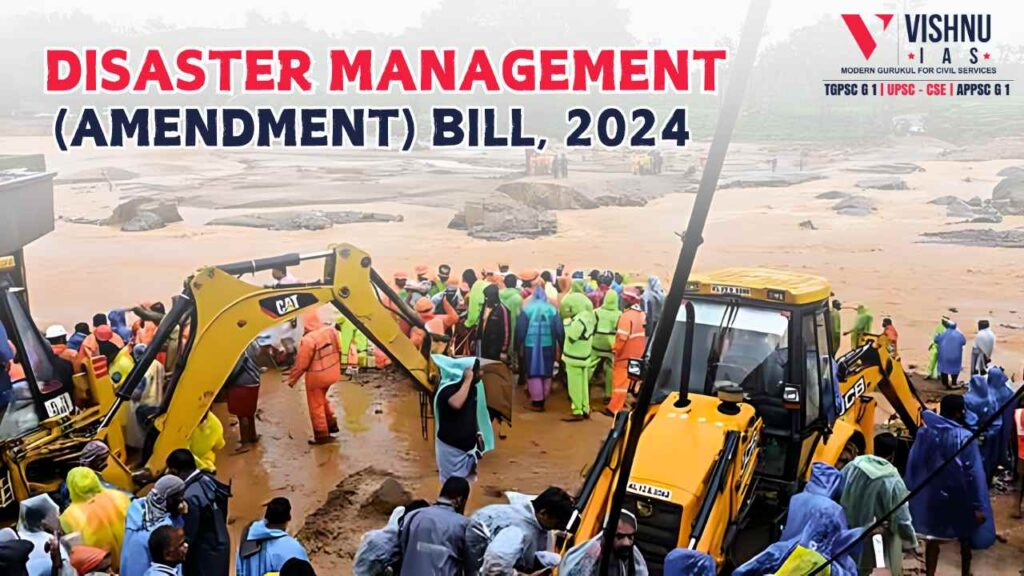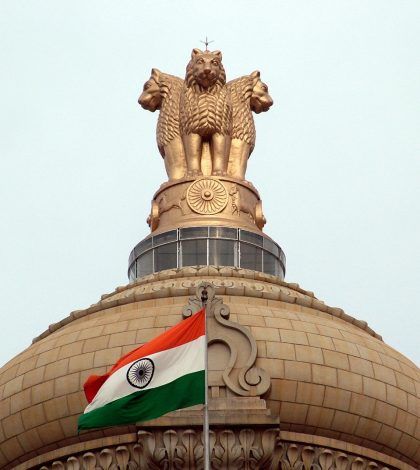Introduction:
- The Disaster Management Amendment Bill, 2024, introduced by the Central Government,marks a significant legislative effort to update the Disaster Management Act, 2005. This amendment is crucial given the increasing frequency and intensity of climate-induced disasters, which demand a more robust and responsive disaster management framework.
- According to the India Meteorological Department, India experienced 536 heatwave days in 2023 alone, the highest in 14 years, underlining the urgency of strengthening disaster management mechanisms.
- The Bill proposes changes that aim to enhance the coordination and effectiveness of disaster response but also raises concerns about centralization and financial devolution, which are critical to the functioning of disaster management in India.
Significance of the Disaster Management (Amendment) Bill, 2024
Enhanced National Coordination:
- The Bill provides statutory status to the National Crisis Management Committee (NCMC) and the High-Level Committee, which are expected to improve coordination at the national level during disasters.
- Example: The delayed response during the 2018 Kerala floods, where multiple agencies were involved without clear coordination, highlighted the need for a centralized authority.
Urban Disaster Management Focus:
- The Bill introduces the concept of an ‘Urban Disaster Management Authority’ specifically for state capitals and cities with municipal corporations, recognizing the unique challenges urban areas face during disasters.
- Case Study: The Mumbai floods of 2005 demonstrated the need for a specialized urban disaster management mechanism, where city specific challenges like drainage and infrastructure need targeted responses.
Integration of Climate-Induced Disasters:
- While the Bill does not explicitly expand the definition of disasters to include events like heatwaves, it indirectly addresses the need by emphasizing climate resilience in disaster management plans.
- Example: The exclusion of heatwaves from the list of notified disasters has been a point of contention, despite over 10,635 deaths from heat/sunstroke between 2013 and 2022.
Strengthening of State and National Plans:
- The Bill mandates the preparation of more comprehensive disaster management plans at both state and national levels, ensuring that these plans are regularly updated to reflect emerging risks.
- Case Study: The Odisha Cyclone Management Plan, updated regularly, played a significant role in the state’s efficient handling of Cyclone Fani in 2019, with minimal loss of life.
Improving Legal and Institutional Frameworks:
- The amendment seeks to solidify the legal frameworks governing disaster management, ensuring that all involved agencies have clearly defined roles and responsibilities.
- Example: The ambiguity in roles during the 2015 Chennai floods led to delayed responses and mismanagement, demonstrating the need for clearer legal frameworks.
Potential Impact on Centralization
Increased Central Control:
- The Bill’s provision for giving statutory status to the NCMC and the High-Level Committee could lead to further centralization of disaster management, potentially reducing the autonomy of state governments.
- Example: The centralization of funds during the COVID-19 pandemic, where states had to rely heavily on the central government for resources, illustrated the risks of excessive central control.
Challenges in Localized Decision-Making:
- Centralization may hinder the ability of local and state governments to make quick, context-specific decisions during disasters, particularly in regions with unique geographical and climatic challenges.
- Example: The localized nature of the 2019 Maharashtra floods required immediate local intervention, which might have been delayed under a more centralized system.
Dilution of Cooperative Federalism:
- The amendment might strain the cooperative federalism model by concentrating disaster management powers at the centre, potentially leading to conflicts between central and state governments.
- Example: The dispute between Tamil Nadu and the central government over the delayed release of NDRF funds during the 2015 Chennai floods reflects the potential conflicts arising from centralization.
Potential for Delayed Responses:
- Centralized decision-making could lead to delays in disaster response, particularly in cases where rapid, localized action is required to mitigate damage and save lives.
- Example: The delayed central response during the 2001 Gujarat earthquake underscored the risks associated with centralized control, where quicker statelevel decisions could have minimized the disaster’s impact.
Erosion of Local Expertise:
- Centralization might undermine the role of local disaster management experts who have in-depth knowledge of regional risks and vulnerabilities, leading to less effective disaster planning and response.
- Example: The centralized handling of the 2013 Uttarakhand floods ignored local warnings, exacerbating the disaster’s impact.
Financial Devolution and Its Challenges
Insufficient Financial Devolution:
- The Bill’s lack of clear provisions for financial devolution may limit the ability of state and local governments to effectively manage disasters, particularly in the immediate aftermath.
- Example: During the 2018 Kerala floods, the state struggled with insufficient funds despite the scale of the disaster, highlighting the need for better financial devolution.
Dependence on Central Funds:
- States may become overly dependent on central funds, which could delay disaster response and recovery efforts, particularly in financially weaker states.
- Example: The reliance of Bihar on central funds during the 2017 floods led to delays in relief efforts, exacerbating the disaster’s impact.
Inadequate Resources for Urban Areas:
- The establishment of Urban Disaster Management Authorities without corresponding financial support might leave urban areas underprepared for disasters.
- Example: The 2020 Hyderabad floods highlighted the financial constraints faced by urban local bodies in disaster preparedness and response.
Challenges in Equitable Fund Distribution:
- The centralized control over the National Disaster Response Fund (NDRF) may lead to inequitable distribution of funds, favouring certain regions over others.
- Example: The uneven distribution of NDRF funds during the 2021 Assam floods, where certain districts received more aid than others, highlights the challenges of centralized fund allocation.
Risk of Financial Mismanagement:
- The lack of financial autonomy at the state level might increase the risk of mismanagement of funds, as states may struggle to align central funds with local needs.
- Example: The financial mismanagement during the 2008 Bihar floods, where allocated funds were not used effectively, highlights the need for better financial autonomy.
Effectiveness of Disaster Response Mechanisms
Delayed Disaster Response:
- Centralized control may result in delays in disaster response, particularly in regions that require immediate intervention, as decision-making would need to pass through multiple layers of bureaucracy.
- Example: The delayed response to the 2005 Kashmir earthquake, where central coordination issues led to significant loss of life and property, underscores the importance of timely intervention.
Reduced Local Empowerment:
- The centralization of disaster management might disempower local authorities, who are often the first responders during disasters, reducing the effectiveness of immediate response efforts.
- Example: The 2018 Kerala floods saw local authorities taking the lead in rescue operations, which might have been hindered under a more centralized system.
Inflexibility in Disaster Response:
- A centralized approach might lead to a one-size-fits-all disaster response strategy, which could be ineffective in regions with unique disaster profiles.
- Example: The uniform disaster response strategy during the 2015 Chennai floods failed to address the specific needs of the affected urban population, leading to prolonged suffering.
Challenges in Capacity Building:
- Centralization might limit the capacity-building efforts at the local level, as states and local authorities may become overly reliant on central resources and expertise.
- Example: The limited capacity of local authorities during the 2020 Assam floods, who relied heavily on central intervention, highlights the challenges of centralized disaster management.
Potential for Inefficient Resource Allocation:
- Centralized control over disaster management resources might lead to inefficient allocation, with resources being directed to areas that may not require them urgently.
- Example: The misallocation of resources during the 2001 Gujarat earthquake, where aid was unevenly distributed, reflects the potential pitfalls of centralized resource management.
Conclusion
- The Disaster Management (Amendment) Bill, 2024, is a crucial step towards strengthening India’s disaster management framework in the face of increasing climate-induced disasters. However, its emphasis on centralization raises concerns about the potential dilution of cooperative federalism, challenges in financial devolution, and the effectiveness of disaster response mechanisms.
- A balanced approach that integrates centralized coordination with localized decision-making and adequate financial devolution is essential for improving disaster resilience in India.
- The way forward includes fostering greater collaboration between central and state governments, ensuring timely financial support to disaster-affected regions, and empowering local authorities to act swiftly and effectively during disasters.


